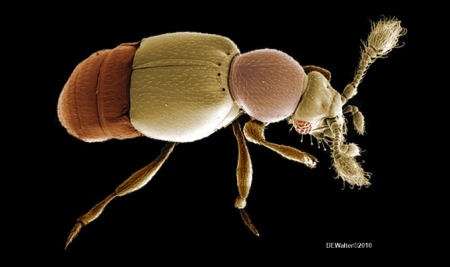I think this small staphylinoid beetle is a member of the Pselaphidae, or what used to be the Pselaphidae – now reduced to a subfamily of Staphylinidae by some authors. Perhaps some knowledgeable pselaphologist can tell me yea or nay (Don Chandler suggests Eupinion sp.). Supposedly there are about 85 species of Pselaphinae known from Canada and Alaska, but this particular one once lived in subtropical rainforest in southeast Queensland.
Pselaphid beetles are interesting to me for two reasons: they tend to be tiny and some eat mites (although more seem to enjoy eating springtails). Others find them interesting because they are ant inquilines and kleptoparasites (i.e. some can trick ants into regurgitating food for them). One of their ‘common’ names is “ant-loving beetles” – although one doubts that they are a common topic of conversation. Also, this common name does tend towards confusion with ‘ant-like stone beetles’ or Scydmaenidae, a topic in the previous post.
In any case, if you would like to spend some time reading about beetles or just looking at some pictures of them – I have good news! The first issue of a brand new blog carnival is up – An Inordinate Fondness – and it is devoted to beetles.

January 31, 2011 at 9:37 pm |
I’m not sure how I wound up here tonight, but I just had to exercise my girly-ness and comment on how amazingly beautiful that staphylinoid is!
February 1, 2011 at 9:04 am |
But not as nice as a really good mite.
July 3, 2012 at 12:47 pm
I could ask if there is truly such a thing as a “really good mite,” but your pselaphine is a Eupinion sp.
July 3, 2012 at 4:42 pm
Well, if you were an Eupinion chowing down on a particularly tasty oribatid, then you might find such questions easy to answer.
July 7, 2012 at 10:16 am |
[…] no particular reason, other than it being a really good mite, I offer a view of a very dead juvenile collected in association with the infamous […]
August 21, 2012 at 4:10 am |
I would love to invite anything that eats spidermites to my garden with open arms. Well, I’d be happy to have them in my garden. #*!*&@ spider mites. They seem to spread powdery mildew, in addition to just being a pain and killing some of my plants, and making others very unhappy.
August 21, 2012 at 6:09 am |
Phytoseiid mites are very efficient predators of spider mites and the ones that are likely to naturally colonize your garden (if you don’t use too many pesticides) will help to keep them under control. If the two-spotted or other spider mites that produce very dense webbing have reached high population levels, though, only the specialist predators like Phytoseiulus persimilis or Galendromus occidentalis are likely to help. There also are some very tiny lady beetles that are good predators of spider mites: http://bugguide.net/node/view/356456
Powdery mildew and spider mites both do best when the plants are water-stressed, so giving your plants plenty of water may help. I’ve mostly given up on my mildew susceptible varieties though (currants, phlox, aster).